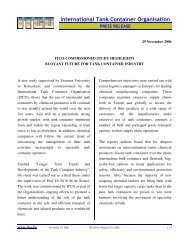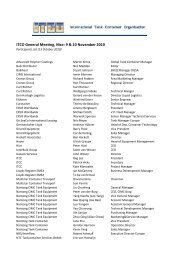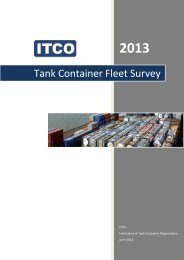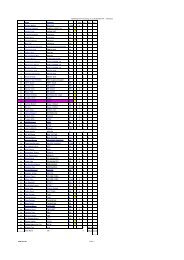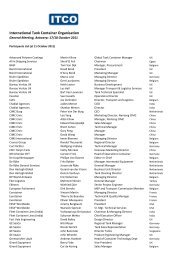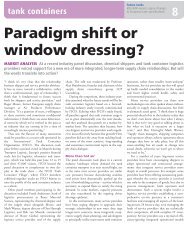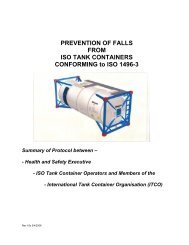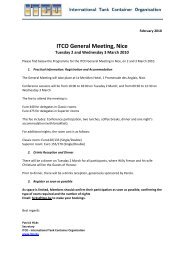Create successful ePaper yourself
Turn your PDF publications into a flip-book with our unique Google optimized e-Paper software.
ICHCA International <strong>Safe</strong>ty Panel Briefing Pamphlet No 30<br />
with a maximum superimposed load <strong>of</strong> 192,000 kg may have up to five units<br />
loaded on top, unless a European unit is placed directly above it or third in<br />
the stack, in which case the stack height would be limited to three or four<br />
above it respectively.<br />
12.3 <strong>Tank</strong> Container Width<br />
12.3.1 Swap tanks are generally wider than ISO tank containers. However the<br />
designs <strong>of</strong> these two types <strong>of</strong> tank container are difficult to distinguish,<br />
especially when seen from a distance. The consequence <strong>of</strong> attempting to<br />
load a swap tank into a standard ISO cell guide may result in the container<br />
becoming jammed.<br />
12.3.2 The additional width <strong>of</strong> the swap tank may also prevent it from being stowed<br />
in lower positions adjacent to other ISO containers as the spacing <strong>of</strong> the<br />
deck fittings are generally too close to be able to accommodate the<br />
additional width. Swap tanks may require stowing where there are no<br />
adjacent containers.<br />
12.3.3 Because <strong>of</strong> the width and the possible reduced stacking capabilities,<br />
shippers who wish to move laden or empty swap tanks on deep sea routes<br />
must confirm that the ship is able to carry them. Furthermore the ship’s<br />
planner must be advised when the container “slot” is booked and the<br />
container delivered to the terminal.<br />
12.4 Segregation<br />
12.4.1 <strong>Containers</strong>, including tank containers, carrying dangerous goods shall be<br />
segregated in line with the IMDG Code.<br />
12.4.2 <strong>Containers</strong> carrying a cargo or its vapour that could adversely affect other<br />
susceptible cargoes should be stowed in separate holds.<br />
12.5 Emergency Response and Clean Up<br />
12.5.1 In the most severe case the pressure vessel could develop a leak or be<br />
punctured.<br />
12.5.2 Such a release could represent a significant emergency response challenge<br />
so consideration must be given to the stowage location.<br />
12.5.3 A commodity that is environmentally hazardous or a hazardous polluting<br />
substance is probably best stowed below deck where leaks or discharges<br />
can be contained within the hold <strong>of</strong> the ship. However it must be recognised<br />
that this may also present a hazard to the crew and/or emergency services<br />
personnel.<br />
12.5.4 Commodities that are extremely difficult to clean-up (for example latex)<br />
should be stowed on deck.<br />
12.5.5 Cryogenic liquids should never be stowed below deck.<br />
12.5.6 Any bulk liquid released into the hold regardless <strong>of</strong> cargo carried may<br />
produce a significant clean-up challenge.<br />
12.5.7 The guidance in dealing with release, spillage, fire or exposure to dangerous<br />
goods given in IMO’s Emergency Response Procedures for Ships Carrying<br />
Dangerous Goods (EmS) and Medical First Aid Guide for Ships (MFAG)<br />
should also be followed.<br />
Page 39 ©ICHCA International Limited



